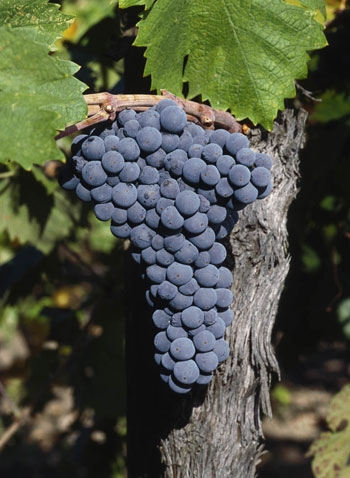UC Blogs
A 'She Bee' on a Hebe
A "she bee" on a hebe.That has a nice ring to it.It was Jan. 7, an unseasonably warm day for winter and we decided to take advantage of it by driving...
Honey bee foraging on hebe. (Photo by Kathy Keatley Garvey)
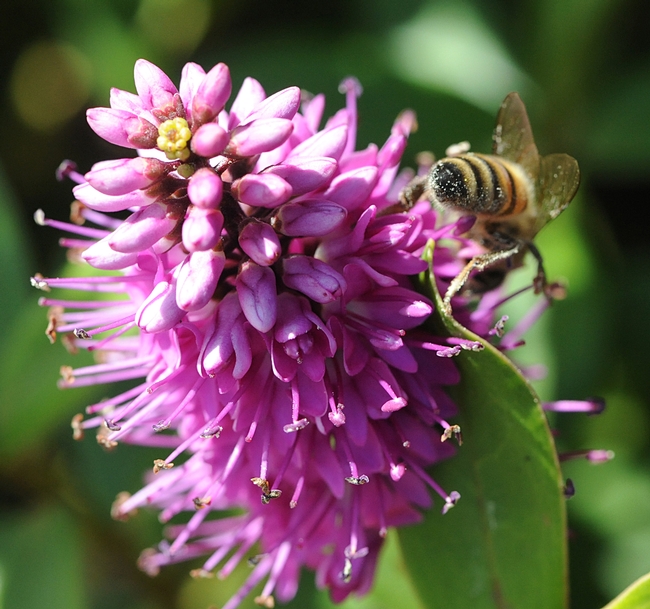
A "she bee" leaving the hebe. (Photo by Kathy Keatley Garvey)
'P' Is for Pollinators
It's good to see the growing number of seminars, lectures and workshops on pollinators.The more we know about our pollinators, the better we'll be...
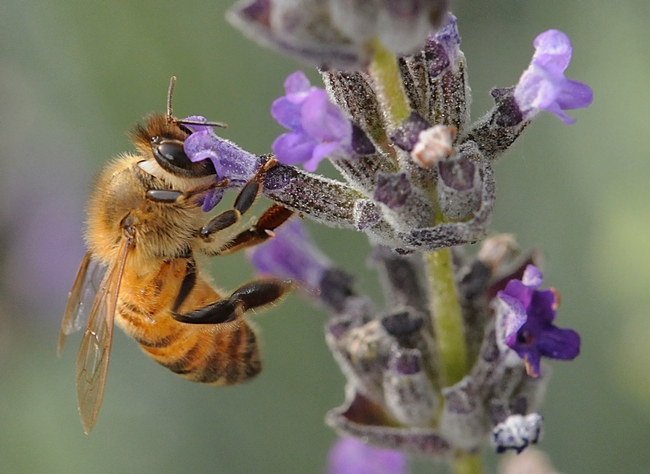
Honey bee foraging on lavender. (Photo by Kathy Keatley Garvey)
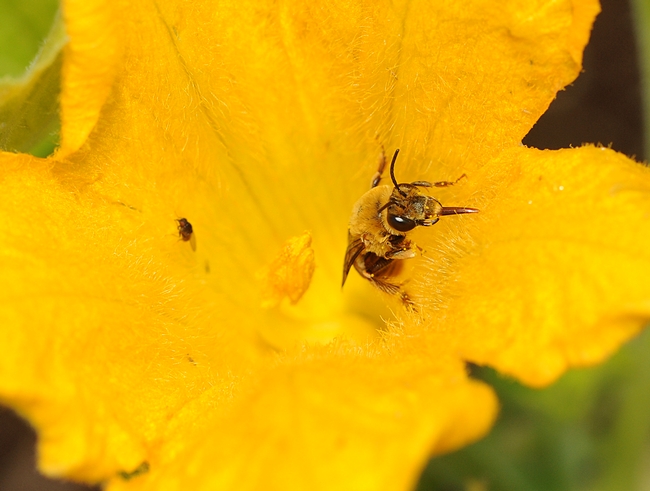
Squash bee (genus Peponapis) on squash. (Photo by Kathy Keatley Garvey)
Salad Bowl
Want an easy project that keeps on giving? How about a salad bowl garden. I saw a very nice example of this easy garden the other day sitting next to my neighbor's front door.
Last October Connie re-purposed a succulent clay pot into a perpetual salad bowl. She
likes mesclun salad greens but not the price. So for a small amount of time and a couple packets of seeds, she created a miniature habitat for growing these garden beauties. Her round clay pot measures about 10 inches across and 4 inches deep. She cleaned her pot and added a mixture of half potting soil and half compost. Fortunately she has a husband who is an active composter, so there is a good supply at hand. She dusted the seeds across the surface and pressed them gently into the soil and misted the surface. She then placed an inverted clear plastic pot liner across the top of the pot to keep the birds out and
to help maintain moisture and heat for the sprouting seeds. She placed her pot in a sunny place in her backyard and since it was still pretty warm in October she checked the moisture level frequently and misted the surface as needed. Within 10 days she was rewarded with tiny shoots of lettuce. When she harvests the lettuce she leaves a couple of inches of growth and the individual plants soon send up new shoots. She reseeded this pot mid-December by gently dimpling the surface with a chopstick and dusting in more seeds. She also moved her pot to the front garden for better sun exposure during the winter. Connie's effort has been rewarded with a nice supply of gourmet greens. The latest Baker Creek Heirloom Seed catalog (http://rareseeds.com/), Renee's Garden (http://reneesgarden.com/) and Peaceful Valley Farm (http://www.groworganic.com/)have a variety of lettuces and greens seeds available for about $3 a packet. Enjoy.
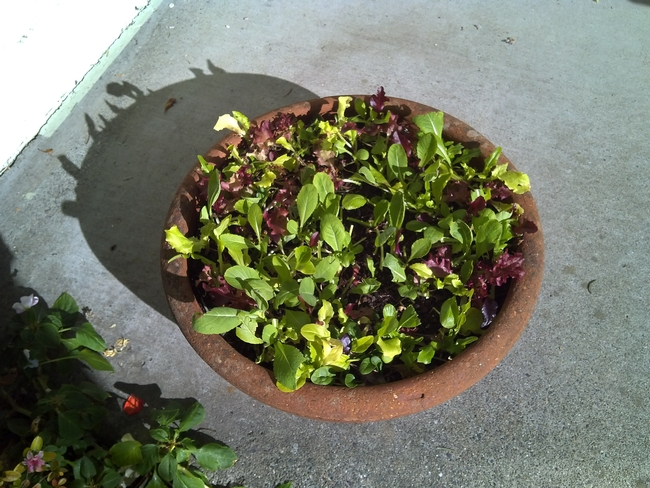
Salad in a bowl. (photo by Trisha Rose)
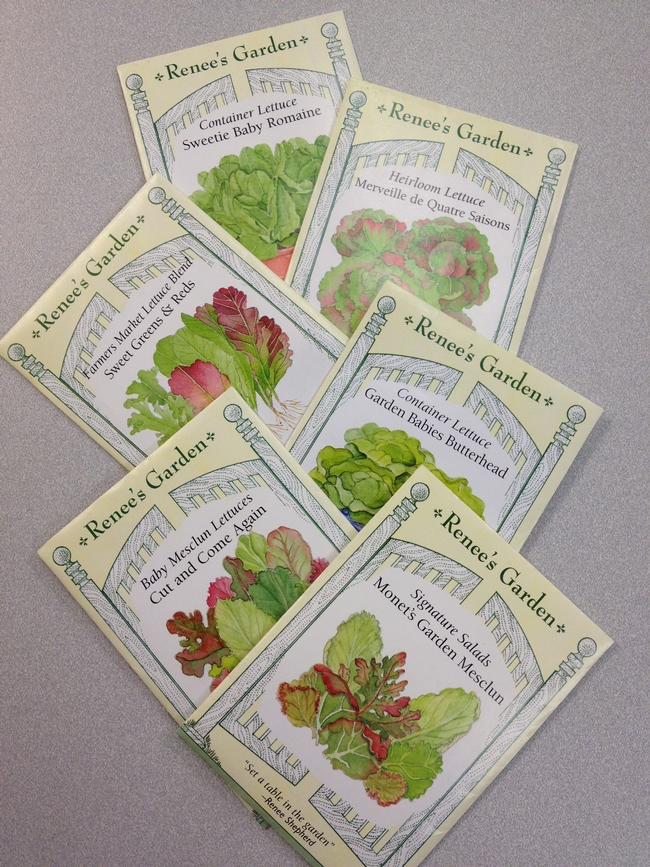
Seeds for a variety of lettuces. (photo by Jennifer Baumbach)
Searching for zinfandel clonal excellence
Wolpert went on a California “safari” to find old-vine selections that had evolved uniquely over time on their own home turf. With support of Association of Zinfandel Advocates & Producers and the American Vineyard Association, UC Davis created the Zinfandel Heritage Vineyard in 1995, the article said, to record, study and preserve distinctive zinfandel clones which they collected from 50 notable old-vine vineyards in 14 counties throughout California. (The Zinfandel Heritage Vineyard website says the vineyard was established in 1989.)
The heritage vineyard helps the industry find answers to some of the mysteries surrounding zinfandel and preserves the special qualities of the old vines for future generations. The vineyard is of historical and viticultural interest, and represents a resource for future plantings of zinfandel with a broad range of selections.
So You Want to Cut a Tree Down?
This blog is for all you “Paul (and Paulette) Bunyans” out there who want to cut something down; specifically, a tree with a chain saw. We’ve all seen people (usually men) operating chain saws with wood chips flying around, shrub or tree becoming a smaller and rather tidy pile of wood and brush. Ever wonder if you too could accomplish this job? Earn bragging rights: “Oh, by the way, I cut down that old tree in the backyard this morning and have a supply of wood for the fireplace, ready to go!” Or did you figure to save the money you’d pay a tree service? You can, but you need the basics first. I run chainsaws in the course of my job, and there is no safer way to operate one of these machines, electric or gas-powered than by knowing the basics and following them every time. Let’s start out with some basics:
The first thing to do before even looking at a chainsaw is to prepare for the task. This means having the correct protective gear or items. Personal Protective Equipment (or PPEs) is your first line of safety when work with machinery.
In this case, a hard hat (helmet) will protect your head from falling limbs or branches. The best helmets will also have a face guard. But, you say, I’m not going to have limbs and branches falling; a helmet will also protect your face from branch/limb tips that may rake across your face while working and prevent large pieces of material from poking you around the eye area.
The next PPE would be safety glasses or goggles; these prevent smaller pieces of debris from your eyes as well. If you wear glasses, use goggles; these are designed to fit snuggly over glasses so that your eyes are totally protected.
Ear muffs or ear plugs will protect your ears from permanent injury from the noise generated by chainsaws. Noise from some gas-powered chain saws can exceed 100 decibels. A hard hat that includes ear muff and a face shield is the best PPE chainsaw work. For the hands, lightweight gloves which fit snuggly, preferably leather will protect your hand from cuts, scratches, and scrapes.
Always wear trim-fitting clothing with, buttoned sleeves; no rings, watches, or jewelry. Loose clothing can snag easily on branches, debris or even the chainsaw itself!
Wear chainsaw chaps to protect your legs from saw kickback. These chaps are made of ballistic nylon fibers that, when cut, clog the chain saw and stop it from cutting any deeper. A side note: I have a pair of chaps at home that have a 10 gash in them at the thigh area. This occurred when I used my thigh to balance a chainsaw when cutting. I’ve never done that again!!!
Last PPE item is good-fitting leather work boots with a minimum of 6” high tops and steel toes to protect your feet.
Remember to know First Aid, especially for severe bleeding, 2nd degree burns (the muffler can get extremely hot), and that all persons in the area know where the First Aid kit is. Please also remember that running a chainsaw is not a 1-person show; even professionals also have 2 people in the area just in case there is an accident.
Now that you are dressed for the occasion, let’s go on and prepare the saw. I’m assuming at this point that you have read the instruction booklets that came with your saw which deal with familiarizing yourself with the operation and care of the chainsaw. Please don’t skip this important step –remember that a chainsaw is not a toy or something to fool around with; treat is as you would treat any piece of machinery, with care and respect!
Make sure that the chain is sharp and tensioned properly. Your operator’s manual will have this information. A chain that is too loose can derail (throw) and can whip back at you; a chain that is too tight will bind and wear out prematurely. Make sure that your saw is clean, with a clean air filter, good spark plug, and have an effective muffler. All the skill in the world will not overcome a dirty, not fully functioning chainsaw. Make sure that it is full of gas and chain saw before staring out. If using an electric saw, make sure that you have a long enough extension cord which is compatible with the amperage of the saw.
Before starting the engine, set the saw on a firm surface in an open arena free of debris or combustible material. Make sure the chain brake is engaged (this stops the blade until you release it). Maintain good balance and have secure footing. Grip the handlebar firmly with the left hand and press down to keep the saw from moving around once it starts. With your right hand, pull out the starter cord until there is a definite resistance and give a brisk, strong pull.
When operating the saw, always hold the chainsaw firmly with both hands; wrap your fingers and thumbs around the handles. Grip the front handle with your left hand and the rear handle with your right hand, even if you are left-handed like me. With your hands in this position, you can best oppose and absorb the push, pull, and kickback forces of the saw without losing control. Keep proper footing and balance at all times. Never use a chainsaw with only one hand!
Finally a list of chainsaw “don’ts”:
When operating a chainsaw, never do the following:
- Work alone
- Work on a ladder or any other insecure support
- Hold the saw above shoulder height
- Overreach to make a cut
- Work in a tree
- Put pressure on the saw when reaching the end of a cut (the pressure may cause the bar and rotating chain to pop out of the cut, go out of control and strike you or some other object.)
- Work at night or in dim light
- Allow other people in the general work area, even when starting the saw
- Operate the saw indoor or in poorly ventilated conditions
- Use the saw to pry or shovel away limbs, roots, or other object
- Refuel a hot saw
- “drop start” a saw as you may drop it after it is started and running
Yes, the above list seems a little on the “Duh!!” side, however, remember that this list exists because someone has done all of these things.
A chainsaw, much like other motorized machinery, can help make a job faster and easier –But only when used properly!


